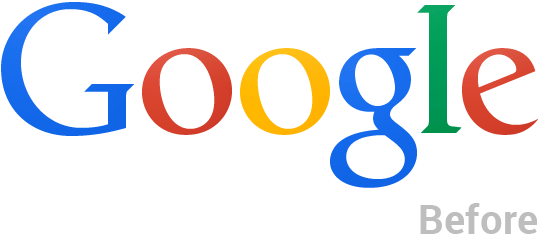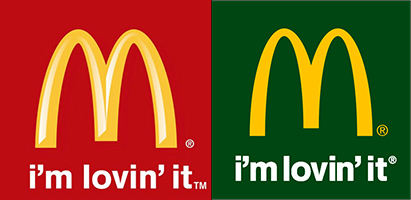Fear and Loathing in Redesign
We examine what the distance between letters affects, why change one blue to another and how to redesign once and for a long time.

In 2015, Facebook introduced a new logo design that is only slightly different from the old. The year before, Google moved two letters in its logo by a couple of pixels, and Visa changed the color of the corner. Why do companies spend money for designers to move letters and change fonts if the old design is more familiar and looks good?



Redesign or restyling is carried out when there is a need to “refresh” the image of the company, while not losing the old audience. Redesign - significant changes in the visual part of the brand, restyling - cosmetic editing of a couple of parts.
Redesign is a common occurrence for companies that occurs every 5-10 years. Decide whether to sprinkle your old logo with ashes and run to the designers for a new one by answering simple questions.
1. Is your logo modern enough?
It is unlikely that there will be a company or application that uses the CD-ROM as a logo, but this is the most obvious example. A font that seemed fashionable to you at the beginning of 2010, after a couple of years, may look like a tasteless relic of the past. Not to mention the use of local memes that you loved with all your heart, but which lost all meaning in a week. A logo that looks obsolete makes your company look obsolete. Especially if competitors do not make such a mistake and "polish" their design if necessary.

2. Does the logo reflect the development of your company?
Perhaps you ordered a logo when you were just starting a business together with a former classmate and rented an office that housed only one table. If over time you have become a group of companies or expanded your sphere of influence, the logo will have to be changed. The logo reflects your company at a particular point in time and evolves with it.

3. Did the workflow remain unchanged?
A couple of years ago you created an app for teens, but it turned out to be much more popular among women in their forties? Have your technologists discovered a new, super-eco-friendly formula that is used only by you? Tell consumers about it through the logo. Communicate with those who choose the product, tell them why you are better and how to solve their problems. The terms “friendly font” or “green eco” may seem pointless, but work anyway. Therefore, Facebook rounds the letters, and McDonald's makes a green logo for Europe, declaring the naturalness of the ingredients.

4. Is your logo easy to adapt?
Did you use the family coat of arms as a logo or what do you pass for it? Did you insist that the designer make the logo more complicated so that you can see what you paid for? Congratulations, you’ve got a character that looks good only in full size and will look terrible on business cards, website and generally everywhere. Complex logos do not look more original and are remembered worse than competitors.

5. Do customers and employees like your logo?
If employees bashfully hide badges with a corporate identity, and customers hold back laughter when they see your business card? I have bad news for you. In 2014, Google made subtle changes to its logo, finally responding to complaints about unequal spacing between letters.
The more often you answered “no” to these questions, the sooner it is worth refreshing your logo.
If there are three basic rules “do & don't” that you should follow when updating the logo.
“Yes”:
- Simplify. The simpler your logo, the easier it is to remember, recognize and use. Simple logos are slower to age and can be used for a company that is changing and growing.
- Make sense. First formulate what the logo will reflect, and then look for its creators.
- Versatility is more important than trends. If today a font or style is used on every sign, it does not mean that it will look just as good in a couple of years.
“No”:
- Do not change the logo, simply because you want to. Do not repair what is not broken.
- Do not change the logo completely. Consumers and the logo have their own relationships that resemble human ones. It is difficult to trust an old acquaintance with a completely new face, especially if he tells you that he has not changed at all. This option is valid only if you are rebranding in order to get rid of the old image.
- Do not forget about the opinions of consumers. If customers have been telling you for ten years that your logo has crooked letters and a disgusting shade of yellow - it's worth changing it.
As a homework, I suggest thinking about why the Wikimart redesign does a better job than Reebok.


In 2015, Facebook introduced a new logo design that is only slightly different from the old. The year before, Google moved two letters in its logo by a couple of pixels, and Visa changed the color of the corner. Why do companies spend money for designers to move letters and change fonts if the old design is more familiar and looks good?



Redesign or restyling is carried out when there is a need to “refresh” the image of the company, while not losing the old audience. Redesign - significant changes in the visual part of the brand, restyling - cosmetic editing of a couple of parts.
Redesign is a common occurrence for companies that occurs every 5-10 years. Decide whether to sprinkle your old logo with ashes and run to the designers for a new one by answering simple questions.
1. Is your logo modern enough?
It is unlikely that there will be a company or application that uses the CD-ROM as a logo, but this is the most obvious example. A font that seemed fashionable to you at the beginning of 2010, after a couple of years, may look like a tasteless relic of the past. Not to mention the use of local memes that you loved with all your heart, but which lost all meaning in a week. A logo that looks obsolete makes your company look obsolete. Especially if competitors do not make such a mistake and "polish" their design if necessary.

2. Does the logo reflect the development of your company?
Perhaps you ordered a logo when you were just starting a business together with a former classmate and rented an office that housed only one table. If over time you have become a group of companies or expanded your sphere of influence, the logo will have to be changed. The logo reflects your company at a particular point in time and evolves with it.

3. Did the workflow remain unchanged?
A couple of years ago you created an app for teens, but it turned out to be much more popular among women in their forties? Have your technologists discovered a new, super-eco-friendly formula that is used only by you? Tell consumers about it through the logo. Communicate with those who choose the product, tell them why you are better and how to solve their problems. The terms “friendly font” or “green eco” may seem pointless, but work anyway. Therefore, Facebook rounds the letters, and McDonald's makes a green logo for Europe, declaring the naturalness of the ingredients.

4. Is your logo easy to adapt?
Did you use the family coat of arms as a logo or what do you pass for it? Did you insist that the designer make the logo more complicated so that you can see what you paid for? Congratulations, you’ve got a character that looks good only in full size and will look terrible on business cards, website and generally everywhere. Complex logos do not look more original and are remembered worse than competitors.

5. Do customers and employees like your logo?
If employees bashfully hide badges with a corporate identity, and customers hold back laughter when they see your business card? I have bad news for you. In 2014, Google made subtle changes to its logo, finally responding to complaints about unequal spacing between letters.
The more often you answered “no” to these questions, the sooner it is worth refreshing your logo.
If there are three basic rules “do & don't” that you should follow when updating the logo.
“Yes”:
- Simplify. The simpler your logo, the easier it is to remember, recognize and use. Simple logos are slower to age and can be used for a company that is changing and growing.
- Make sense. First formulate what the logo will reflect, and then look for its creators.
- Versatility is more important than trends. If today a font or style is used on every sign, it does not mean that it will look just as good in a couple of years.
“No”:
- Do not change the logo, simply because you want to. Do not repair what is not broken.
- Do not change the logo completely. Consumers and the logo have their own relationships that resemble human ones. It is difficult to trust an old acquaintance with a completely new face, especially if he tells you that he has not changed at all. This option is valid only if you are rebranding in order to get rid of the old image.
- Do not forget about the opinions of consumers. If customers have been telling you for ten years that your logo has crooked letters and a disgusting shade of yellow - it's worth changing it.
As a homework, I suggest thinking about why the Wikimart redesign does a better job than Reebok.

